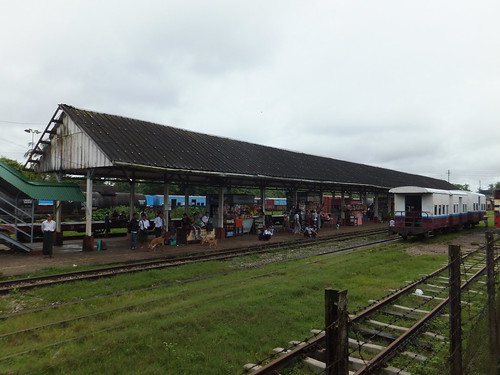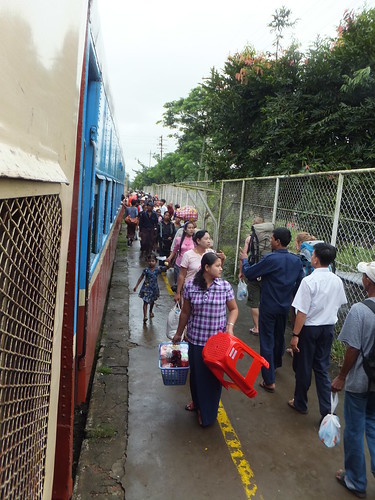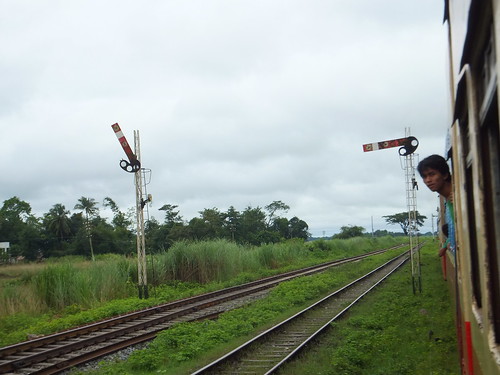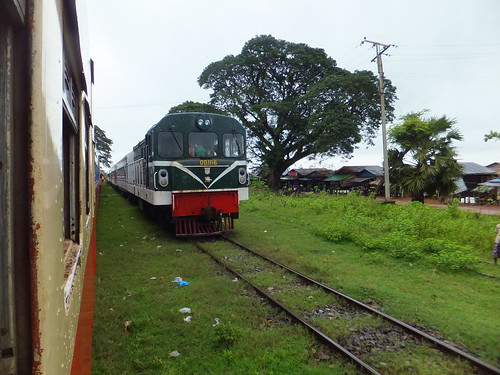During my trip to Burma in 2012 (described in a series of posts here), I travelled by train from Yangon via Bago to Kyaikto. This post describes the journey from Bago to Kyaikto with a bit more technical detail. The first part of the journey, from Yangon to Bago, is described here. For this description, I've assumed the 'Down' direction is away from Yangon (although I've found one source which contradicts that). I've called the two signal boxes at Bago 'South' and 'North', based on the geography, but I don't know their official designation.
Journey made on Saturday, 8th September 2012
This post describes the second half of an uncomfortable (but interesting) journey from Yangon to Kyaikto.
Bago Station. Four-wheel coaches in the central siding, freight vehicles in the background.
Bago is still an important station and has two mechanical signal boxes, one at each end of the station. When we stopped, large numbers of passengers got on and off. At least some of the people getting off were 'hawkers' selling drinks, food and all sorts of things to passengers. I presume they intended to catch the next train heading towards Yangon to continue the "at-your-seat service".
Passengers (and 'hawkers') getting on and off our train at Bago.
After a brief stop, our train continued, swinging violently over the pointwork near the North Signal Box as we made our way to the line to the Mawlamyine.
A magnificent 5-doll lattice-post bracket signal.
I managed a couple of shots of a magnificent 5-doll lattice-post bracket signal with 3 upper-quadrant main arms (the centre one with a ring which I assume means 'Goods Line') and two lower-quadrant miniature arms. All the arms had proper spectacles but no glass in the spectacles and no lighting. Balance weights (like most of the semaphore signals I've seen in Burma) were fitted at high level. Amazingly, four of the five dolls retained their elegant finials. From its style, this signal must have been imported from the U.K.
Leaving Bago on the line to Mawlamyine.
We passed under a steel truss gantry signal carrying what I presume are the Up Home signals for the North Signal Box. The signal dolls were lattice post but I couldn't get a proper look at the complete structure. Bago had one more puzzle for me. We were now travelling on the rightmost of three lines where the two on our left apparently formed the double-track to the north. Where you would expect the North Signal Box down starting signals, there were, indeed, two lattice posts (neither with finials), both fitted with the weird 'lower quadrant arm arranged as upper quadrant' I'd seen before, one with a 3-aspect spectacle, the other a 2-aspect spectacle!
Bago North Signal Box down starting signals.
It would take another three hours to reach Kyaikto on the single line, making our way through a number of stations with passing loops, sometimes taking the left track, sometimes the right. We made brief stops at some of these stations. About an hour out of Bago, we stopped at a slightly larger station with the normal passing loop and a third loop line presumably originally intended for loading/unloading goods vehicles because a single-lever ground frame controlling a trap point was provided at each end of the station. There was also an abandoned water column. Leaving this station, I almost missed our passage over a Scherzer Rolling Lift Bridge. After a further half hour of travelling, another line appeared on our left and trailed into our route. I think this formed a connection further north with the line from Bago to Mandalay. About two hours out of Bago, we stopped for a moment at a station where the loop line was blocked by a single open wagon. After another twenty-five minutes, we stopped at another station where the other line was occupied by a Yangon-bound train waiting for us to arrive, headed by D.1116.
DD.1116 heading towards Yangon with a passenger train waits for us to clear the single line.
After a further half an hour, we arrived at Kyaikto where I got off exhausted with being thrown about.
If anyone can offer any clarification of Myanmar Railways practices, it would be welcome.
Train Timing and Photograph Locations
As yet, most of the stations are unidentified. There's a table below showing approximate journey time from leaving Yangon (hours:minutes), photo reference (prefixed 'DSCF') and brief description. There are links to the Sets containing these pictures in 'Photographs' below.
| Elapsed Time |
Photo Ref |
Description |
| 1:54 |
6009 |
Bago South Down Outer Home |
| 1:55 |
6011 |
Bago South Down Home Gantry |
| 1:57 |
6019 |
Bago Station |
| 2:01 |
6021 |
Leaving Bago Station |
| 2:02 |
6025 |
Bago North Up Home Gantry |
| 2:12 |
6027 |
Down Home Bracket |
| 2:13 |
6028 |
Station A |
| 2:32 |
6032 |
Down Home Bracket |
| 2:32 |
6033 |
Station B |
| 2:33 |
6034 |
Ground frame exiting loop |
| 2:48 |
6035 |
Down Outer Home |
| 2:48 |
6036 |
Down Home Bracket |
| 2:50 |
6037 |
Trap Point Ground frame |
| 2:52 |
6038 |
Station C |
| 2:54 |
6039 |
Trap Point Ground Frame |
| 2:54 |
6042 |
Up Home Bracket |
| 2:55 |
6043 |
Rolling Lift Bridge |
| 3:13 |
6044 |
Down Home Bracket |
| 3:22 |
6046 |
Down Outer Home |
| 3:24 |
6048 |
Junction Ground Frames |
| 3:22 |
6049 |
Junction Ground Frame |
| 3:24 |
6050 |
Junction Ground Frame |
| 3:35 |
6054 |
River Bridge |
| 3:40 |
6056 |
Approaching Station |
| 3:41 |
6057 |
Station D |
| 3:41 |
6058 |
Station D |
| 3:44 |
6059 |
Up Home Bracket |
| 4:02 |
6065 |
Station E |
| 4:03 |
6066 |
Leaving Station E |
| 4:04 |
6067 |
Leaving Station E |
| 4:24 |
6068 |
Arriving Station F |
| 4:25 |
6069 |
Station F |
| 4:25 |
6070 |
Station F |
| 4:26 |
6071 |
Up Home Bracket |
| 4:39 |
6072 |
Down Outer Home |
| 4:40 |
6073 |
Down Home Bracket |
| 4:42 |
6074 |
Station G |
| 4:53 |
6075 |
Kyaikto Down Distant |
| 4:54 |
6076 |
Kyaikto Down Outer Home |
| 4:56 |
6077 |
Kyaikto Down Home Bracket |
| 4:58 |
6079 |
Kyaikto Station |
Photographs
Bago Station.
Bago to Kyaikto by Train.
[Revised 20-Dec-2012]






